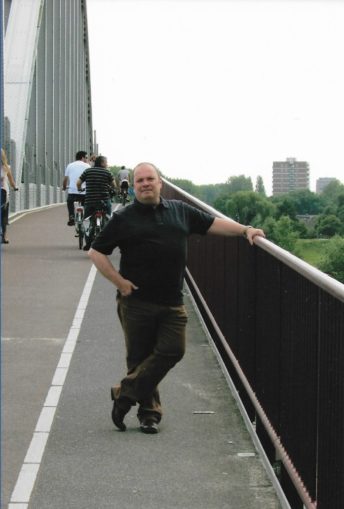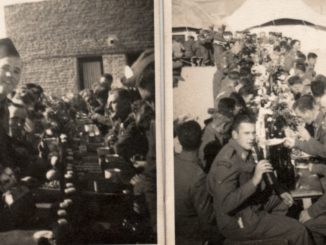
Bundesarchiv, Bild 101I-567-1503B-23 / Schneiders, Toni / CC-BY-SA 3.0, CC BY-SA 3.0 DE, via Wikimedia Commons
The gliders wallowed behind their Heinkel 111 tug aircraft in the thin, turbulent air above the mountains. The lead aircraft sighted the long mountain ridge and the Gran Sasso Mountain behind it, gave the order to their charges to cut the tow cables and made a hard left turn to clear the gliders. The relatively small gliders were buffeted by the swirling air currents, but the pilots had spotted the tiny cluster of buildings that was the Hotel Campo Imperatore and the air brakes on the wing upper surfaces were applied to slow the gliders and increase their rate of descent. As they came closer to their target, the glider pilots realised to their horror, that the small meadow they had planned to land on was in fact a very steep hillside. With little in the way of alternatives, the pilots elected to crash-land on the boulder-strewn, but flatter ground in front of the hotel. Skorzeny urged his glider pilot to get down as close to the hotel as possible, whatever the risks.
Inevitably there were casualties as the first glider containing Skorzeny and his team thumped down at 1405. Skorzeny stumbled out of the partially wrecked glider and headed for the hotel, leaving his MP 40 machine pistol behind. He went through the first door he found open, ending up in a dead end room that housed radio equipment and a very surprised operator. He angrily smashed the equipment and ran back outside, finding two of his NCOs who fortunately had remembered their weapons. The second glider landed with the first of the more heavily equipped paratroopers, to provide control to secure the area and give back-up while Skorzeny went round the rear of the building to try to find an unlocked door.
Inspector General Giuseppe Gueli, commander of the Carabinieri was rather surprised to be awoken from his afternoon nap by one of his men, to be told that gliders were landing outside. He looked out of the window at the airborne troops running towards the hotel and yelled at his men not to shoot, immediately causing utter confusion but potentially avoiding a bloodbath. Gueli’s second in command seemed to have more of a grasp of the situation and rushed up to the floor where Mussolini was being held. He was mulling over whether to shoot Mussolini if the Germans entered the building when Il Duce explained that the Germans would kill everyone if any harm came to him.
After noticing that the guards had dropped their weapons or were making no attempt to engage the assault force, Skorzeny climbed up the outside of the hotel to reach Mussolini’s room. According to his account, the following exchange took place: “Duce, the Führer sent me to free you”, he said. “I knew that my friend Adolf Hitler would not have abandoned me!” responded Mussolini. It is advisable to take this account with a hefty pinch of salt, because in all of the photographs taken at the hotel, Mussolini looks plainly terrified. One rather gets the impression he was enjoying the relative luxury of his captivity. The time was now about 1415 hours, about ten minutes since Skorzeny landed and about the same time that the lower cable car station was secured by the ground column. Skorzeny also claimed to have observed gliders six, seven and eight crash land around this time through the windows. The entire operation at Hotel Campo Imperatore was completed without a shot fired in anger; the only round fired was a negligent discharge, when an airborne soldier squeezed the trigger by accident when he exited his glider.
The ground element led by Mors had been required to make several detours due to partisan activity and it was deemed too dangerous to take Mussolini out by road. A small Feisler Storch Army observation aircraft was requested while the paratroops cleared the landing ground of boulders and marked a landing strip. Amazingly it appeared that German airborne forces radios actually worked, unlike those of the British. After the initial tension, the atmosphere at the hotel became relaxed, Germans and Italians drinking wine together a posing for mutual photographs. Skorzeny made sure that he appeared in as many of these photographs as possible, although he later claimed to be “frustrated” by the cameraman’s presence during the operation.
At 1500, Skorzeny escorted Mussolini out of the building for more photo opportunities with Il Duce’s gallant rescuers, obviously Skorzeny featured prominently in these pictures. It has to be said that Mussolini looks far from happy in these photographs, the once strutting dictator hunched in a black hat and overcoat from which frightened and haunted eyes stare back at the camera. At around 1550 the Feisler Storch landed and Mussolini was escorted to the aircraft by Skorzeny, and naturally this was another opportunity for a photo shoot. At this point taking everyone by surprise, Skorzeny jumped into the Storch despite the protestations of the pilot. The aircraft’s engine was run up to full power, while the paratroopers hung onto it, then the grossly overloaded little aeroplane wobbled down the airstrip and disappeared over the edge of the mountain. The watchers ran to the edge to see the Storch struggle to regain altitude in the valley below. It landed at Pratica di Mare at 1615 hours, where Mussolini and Skorzeny transferred to a Heinkel 111 bomber, and flew to Germany via Vienna.

Bundesarchiv, Bild 101I-567-1503C-15 / Toni Schneiders / CC-BY-SA 3.0, CC BY-SA 3.0 DE, via Wikimedia Commons
Reichsfuhrer Himmler was determined to milk the commandos’ rescue mission for all the propaganda value he could wring from it. The swift but meticulous staff planning conducted by Major Mors and his paratroopers taking control and securing of the landing site, while Skorzeny was dashing around seeking glory, were airbrushed from the official Nazi history. Skorzeny was awarded the Knights Cross with Oak Leaves and Student complained bitterly to Herman Goering about Skorzeny taking all the credit for the success of the mission. Goering did nothing.
Mussolini was a changed man in the years following his “rescue” from Gran Sasso. Pressured by Hitler, he set up a new regime called the Italian Social Republic, later the Salo Republic but he was by now, nothing more than a puppet leader for his German master. By 1945 the Allies were advancing into northern Italy, the Salo Republic was collapsing, so Mussolini together with his mistress Clara Petacchi and other exiles headed to Switzerland for a flight to Spanish exile. On the 27th April 1945 Mussolini’s entourage was stopped by communist partisans near the village of Dongo. They were taken to Giulino di Mezzegra and summarily shot with most of their fellow travellers, mainly officials and ministers from the Salo Republic. From there their bodies were taken to Milan where they were shot, kicked, spat upon, before being hoisted to hang upside down from an ESSO petrol station. Mussolini’s corpse was interred in an unmarked grave, before being stolen by neo-Fascists. Finally the recaptured the remains were interred in a crypt at Predappio in Romagna, his birthplace.

Vincenzo Carrese, Public domain, via Wikimedia Commons
Kurt Student fought in Normandy and against the British airborne forces during MARKET GARDEN. He was captured by the British in 1945, put on trial for the murder of prisoners in Crete and sentenced to five years in prison, commuted because of health reasons.
Otto Skorzeny was held as a prisoner for two years after the war and tried for war crimes at the Dachau trials. This was because during the Ardennes Offensive his unit had dressed in American uniforms, to infiltrate behind the American lines. He escaped from an internment camp in July 1947 probably with the help of the ODESSA organisation and settled in Madrid, where he set up a small engineering business. He acted as a military advisor for the Egyptians and the Peron regime in Argentina. Mossad hatched a plot to have him assassinated, but its chief Issel Harel decided to try and recruit him instead. Perhaps unsurprisingly given its long memory and reach, Skorzeny agreed to supply Mossad with a list of German scientists conducting military research in particular rocketry for the Egyptians, scientists who subsequently disappeared or were taken ill permanently. Skorzeny was paralyzed following treatment for cancer which eventually killed him in Madrid in 1975. He was given a Catholic funeral in line with his faith, his coffin draped in the Nazi colours of red and black. The funeral was attended by former SS members and his ashes were taken to Vienna for internment in the family plot.
© Blown Periphery 2023

Christophe Downes 28th July 1957 – 30th March 2023



